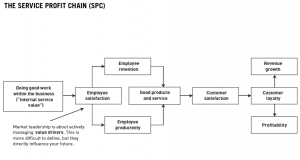Great Small Business Ideas to Start: The Employee – Customer – Profit chain
S ears provides one of the best examples of employee practices connecting directly with organizational performance. The employee–customer–profit chain (a variation on the service profit chain) makes explicit the links between cause and effect. By enabling employees to see the implications of their actions, it can change the way people think and the results they achieve.
The idea
Traditionally, managers focus on results. However, this data is historical. What is really required for market leadership is an emphasis on managing value drivers (the aspects of the business that make the greatest difference and provide most benefit to customers). Of these value drivers, employee retention, employee satisfaction, and employee productivity significantly affect customer satisfaction, revenue growth, and profitability. This is highlighted in the diagram of the service profit chain opposite.
In the early 1990s, senior executives at American retailer Sears realized that future performance was not going to improve simply by developing a different strategy or adjusting marketing plans.
Following significant losses, executives focused on three issues:
- How employees felt about working at Sears.
- H ow employee behavior affected customers’ shopping experience.
- How customers’ shopping experience affected profits.

Sears asked 10 percent of its workforce how much profit they thought was made for each dollar of sales. The average answer was 46 cents, whereas in reality it was 1 cent. This highlighted the need for employees, especially those at the front line, to better understand the issues determining profitability. Sears’ approach was to develop the employee–customer–profit model (ECPM), making explicit the chain of cause and effect. Because employees were better able to see the implications of their actions, it changed the way they thought and acted. This, in turn, was reflected in bottom-line performance.
The Sears approach to creating an ECPM (which is a specific version of the service profit chain) started by devising a set of measures based on objectives in three areas: making Sears a compelling place to work, a compelling place to shop, and a compelling place to invest.
For the top 200 managers at Sears, incentives are based on total performance indicators (TPI)—which include non-financial and financial measures.
- One-third on employee measures—attitude about the job and company
- One-third on customer measures—customer impression and retention
- One-third on financial measures—return on assets, operating margin, and revenue growth.
As a result of the employee–customer–profit chain, managers at Sears are recruited, promoted, and appraised on the basis of 12 criteria:

- Customer service orientation.
- Initiative and sense of urgency.
- Business knowledge and literacy.
- Problem solving.
- Developing associates and valuing their ideas.
- Teamworking s kills.
- Two-way communication skills.
- Valuing diversity.
- Empowerment s kills.
- Interpersonal s kills.
- Change leadership.
- Integrity.
These are grouped into three areas—the three Ps: passion for the customer, performance leadership, and people adding value.
In practice
- Find opportunities for managers and marketing professionals to share customer data. HR has data about what motivates and engages people, while marketing has insights about external customers’ needs. Develop a process that manages the causal links between factors.
- Blend intuition and common sense with sound statistical analysis.
- Understand the elements of workforce success—what makes employees productive, effective, and willing to use their initiative to achieve the organization’s goals. Awareness of these issues and how they can be applied provides HR with another essential role in ensuring the firm’s commercial success.
- Make sure that measures are not over-complicated or excessively elaborate, when what is needed is a practical, robust, and informed approach.
